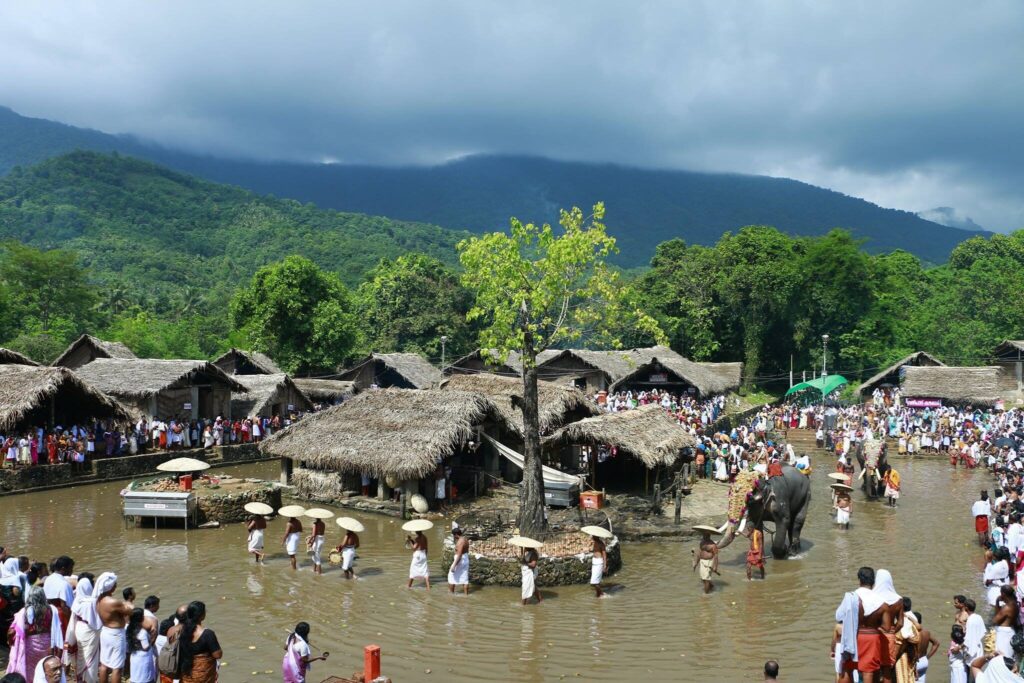Abstract
The Kottiyoor Temple, located in Kannur district, Kerala, holds a significant place in the religious and cultural landscape of the region. Known as Vadakkeshwaram or Ikkare Kottiyoor, the temple stands on the western bank of the Vavali River, while a temporary hermitage, Kizhakkeshwaram or Akkare Kottiyoor, sits on the eastern bank, used exclusively for the annual Kottiyoor Vysakha Mahotsavam. The temple complex, overseen by the Malabar Devaswom Board, lies within an 80-acre sacred grove, now designated as a wildlife sanctuary by the Kerala government. This paper provides an in-depth historical, cultural, and religious analysis of the Kottiyoor Temple, its legends, and its rituals.

Historical Context and Etymology
The name ‘Kottiyoor’ is derived from the term ‘Katti-yoor,’ originating from the Kattan dynasty of Puralimala, later phonetically adapted in the local dialect. Historical evidence suggests that this site, renowned as Thruchherumana Kshetram, has held ritual significance for centuries. The temple’s location is symbolically important as it is believed to be the site of the mythological Daksha Yaga, where Sati Devi immolated herself, marking it as a sacred Shakti Peetha dedicated to Goddess Sati. The temple became a focal point of religious practices and local folklore, with the dense forested region surrounding it preserved as a sanctuary to maintain its ancient sanctity.
Temple Architecture and Sacred Structures
`The Kottiyoor Temple is noted for its unique absence of permanent structural edifices in its Akkare (east bank) complex, with temporary structures symbolizing the simplicity and asceticism associated with sage hermitages. A central feature of Akkare Kottiyoor is the Swayambhoo linga, believed to be self-manifested, located on the ‘Ammarakkalu Thara’ – a raised platform where Sati Devi is said to have immolated herself. This area remains untouched by permanent construction due to its sacral significance.
On the western bank, the Thruchherumana Temple (Vadakkeshwaram) operates year-round, honoring Shiva and hosting rituals for the Swayambhoo linga exclusively during the Vysakha Mahotsavam. Installed by the legendary Parashurama and later visited by the philosopher-saint Adi Sankaracharya, this temple is viewed as a representation of Shiva’s union with Prakruti (nature).
Rituals and Ceremonies of Vysakha Mahotsavam
The Kottiyoor Vysakha Mahotsavam, celebrated annually for 28 days in May-June, commemorates the Daksha Yaga and reinforces the temple’s cultural relevance. Rituals commence with ‘Neyyattam’ on Chodi day, succeeded by ‘Bhandaram Ezhunnallath’ where ceremonial vessels and ornaments are brought from nearby Manathana village.
Unique to this festival is the ‘Elaneer Vayppu’ ritual, where devotees present tender coconuts to the Swayambhoo linga. The coconut water, collected in gold and silver pots, is used in the sacred ‘Elaneeraattam’ ceremony, or ‘Rashi Velli,’ highlighting the temple’s connection with the community. Other significant rites include Rohini Aradhana, during which the Kurumathoor Brahman, embodying Vishnu, performs ‘Aalingana Pushpanjali,’ symbolizing Vishnu’s embrace of Shiva in compassion. The festival concludes with the ‘Thrikkalashaattu’ ceremony, featuring a grand procession where elephants carry idols of Shiva and Parvati.

Communal Participation and Cultural Heritage
Historically, local Hindu communities have specific roles within the festival as decreed by the Kottayam (Pazhassi) royal family. The tradition of communities providing essential materials from distant locations endures, illustrating the temple’s sociocultural integration. For example, the Thammangadan Nambiar family has a hereditary right to offer the initial ghee in the ‘Naallam Thurakkal’ ritual. This hereditary role is esteemed as a form of cultural inheritance, representing continuity in the temple’s ritual life.
Sacred Associations with Other Temples
The Kottiyoor Temple maintains ritualistic connections with other temples, reflecting an extensive network of sacred geography within Kerala. Historically, rice was offered to Kottiyoor from the Tirunelli Maha Vishnu Temple in Wayanad. Despite the discontinuation of this offering, symbolic rituals are upheld at both sites. Additionally, the Mutherikavu temple provides the ceremonial sword for the festival, and other neighboring shrines contribute ritual items, reinforcing inter-temple alliances.
Symbolism and Mythology
Kottiyoor Temple’s mythology resonates with Hindu cosmological themes, particularly those of Shaivism and Shaktism. The site’s mythology, enshrined in narratives of the Daksha Yaga, binds it to a divine sequence of events involving the Trimurthy (Brahma, Vishnu, and Shiva) and Shakti. The absence of Kali from the temple premises, a promise given to Parashurama in the presence of Trimurthy, epitomizes the temple’s purity and sacredness. The temple’s establishment is mythologically linked to Parashurama, who, according to legend, created the Kerala region. Sankaracharya’s abstention from crossing the river to the Swayambhoo linga during non-festival periods further strengthens the belief that Shiva prefers isolation outside the Vysakha Mahotsavam, adding to the site’s mystery and reverence.
Conservation and Ecological Significance
The temple’s ecological setting within a declared wildlife sanctuary underscores its role as a conservationally sacred landscape. The forested grove remains largely undisturbed, mirroring the temple’s conservative approach to preservation, symbolically reflecting its ethos of maintaining natural sanctity.
Conclusion
The Kottiyoor Temple exemplifies a sacred, communal, and ecological continuum that spans centuries. Its traditions, meticulously preserved by the community and the Malabar Devaswom Board, retain the essence of Kerala’s religious heritage. The temple’s annual festival, sustained by community participation and rooted in mythological history, showcases an unparalleled model of indigenous conservation, ritual purity, and communal harmony. The Kottiyoor Temple thus stands not only as a religious site but as a testament to the region’s layered cultural and environmental heritage.

The Write, Alan C Dominic, is an archaeology post graduate from University of Kerala, currently pursuing a post graduate diploma in Museology and Conservation at University of Jammu. He was also a part of UNESCO World Heritage Volunteer Camp 2023, organised at Ramappa Temple in Warangal.
